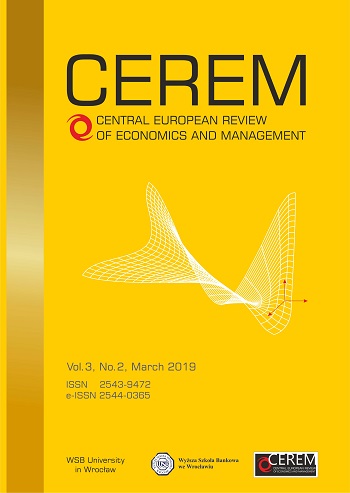Improving students’ performance by means of motivation: the role of ICTs
DOI:
https://doi.org/10.29015/cerem.754Słowa kluczowe:
educative innovation, students, motivationAbstrakt
Abstract:
Aim: The main objective of this paper is to analyze the effects of educational innovation on student implication on the study as a way for getting a job in the future, as well as the role of motivation at the secondary school to help for achieving this goal.
Design / Research methods: By means of the elaboration of a questionnaire, the opinion of the students in relation to educative innovation, and, later by means of descriptive statistical analysis and a regression analysis, to search the relation between the concerns for getting a job and the motivational education among the students in secondary educative level is undertaken.
Conclusions / findings: The results point towards a positive assessment by the students, who consider that educational innovation, stimulates their interest; boost the participation and collaboration between peers and with the teaching staff, at the same time there is a statistical significant relation between the students’ concern about their future working life and the motivations at school. The motivation is strongly relate to incorporation of ICTs at classroom, particularly computers and tablets.
Originality / value of the article: The main value of this research is on stablishing a link between three key features: the concerns of youth about their future labor life, the motivation at school and the role of ICTs on this motivation.
Limitations: The main limitations of this research are related to the sample, nevertheless the preliminary generalization of this results can be acceptable, according the literature.
Bibliografia
Atkinson, J. W. (1964), An introduction to motivation. Princeton, NJ: Van Nostrand.
Bandura, A. (1986),. Social foundations of thought and action: A social cognitive theory. Englewood Cliffs, NJ: Prentice-Hall.
Bandura, A. (2001), Social cognitive theory: An agentive perspective. Annual Review of Psychology, 52, 1-26.
Bandura, A. (2005), The primacy of self-regulation in health promotion. Applied Psychology: An International Review, 54, 245 – 254.
Bandura, A. (2006), Going global with social cognitive theory: From prospect to paydirt. In S. I.
Donaldson, D. E. Berger, & K. Pezdek (Eds.), The rise of applied psychology: New frontiers and rewarding careers (pp. 53 – 70). Mahwah, NJ: Erlbaum.
Bryan, R. R., Glynn, S. M., & Kittleson, J. M. (2011), Motivation, achievement, and advanced placement intent of high school students learning science. Science education, 95(6), 1049-1065.
Gagne R. M. & Briggs L. J. (1979), Principles of instructional design. New York: Holt. Rinehart and Winston.
Gagne R. M. (1965),. The conditions of learning. New York: Holt, Rinehart and Winston.
Gagne R. M. (1972), Domains of learning. Interchange 3, 1-8,
Gagne R. M. (1984), Learning outcomes and their effects. American Psychology, 39, 377-85.
García Sedeño, M. A., Barbero García, M. I., Avila Carretero, I., & García Tejera, M. C. (2003), La motivación laboral de los jóvenes en su primer empleo. Psicothema, 15(1), 109-113.
Hyland, N., & Kranzow, J. (2011), Faculty and student views of using digital tools to enhance self-directed learning and critical thinking. International Journal of Self-Directed Learning, 8(2), 11-27.
Hyland, N., & Kranzow, J. (2011), Faculty and student views of using digital tools to enhance self-directed learning and critical thinking. International Journal of Self-Directed Learning, 8(2), 11e27.
Jacinto, C. (2008), Los dispositivos recientes de empleo juvenil: institucionalidades, articulaciones con la educación formal y socialización laboral. Revista de Trabajo, 4(6), 123-142.
Pajares, F., & Schunk, D.H. (2001), Self-beliefs and school success: Self-efficacy, self-concept, and school achievement. In R. Riding & S. Rayner (Eds.), Self-perception (pp. 239 – 266). London: Ablex Publishing.
Pérez, P. E. (2013), Empleabilidad, motivación por trabajar y políticas de empleo para jóvenes en Argentina. Cuestiones de sociología, (9) 1-4 (available on http://ri.conicet.gov.ar/bitstream/handle/11336/3887/Empleabilidad__motivaci_n_por_trabajar_y_politicas_de_empleo_pra_j_venes_en_Argentina.pdf?sequence=1 , downloaded on May, 2018).
Prensky, M. (2001), Digital natives, digital immigrants part 1. On the horizon, 9(5), 1-6.
Prensky, M. (2011), Enseñar a nativos digitales. Ediciones SM. Madrid..
Schunk, D. H., Pintrich, P. R., & Meece, J. L. (2008). Motivation in Education 3rd ed Upper Saddle River. NJ: Pearson.
Sini, B., Muzzulini, B., Schmidt, S., & Tinti, C. (2018), School motivation: A comparison between Kenya and Italy. The Journal of Educational Research, 1-10. https://doi.org/10.1080/00220671.2018.1427035.
Pobrania
Pliki dodatkowe
Opublikowane
Numer
Dział
Licencja
Autor przenosi nieodpłatnie na Wyższą Szkołę Bankową we Wrocławiu , bez ograniczeń terytorialnych, majątkowe prawa autorskie do tego utworu w rozumieniu ustawy z dnia 4 lutego 1994 roku o prawie autorskim i prawach pokrewnych ( Dz.U. 1994, Nr 24, poz. 83 ze zm. )na zasadzie wyłączności, tj. prawo do:
a) wyłącznego używania i wykorzystania utworu w dowolnej działalności przez Wyższą Szkołę Bankową we Wrocławiu, w szczególności w działalność Biblioteki Cyfrowej uruchomionej przez Wyższą Szkołę Bankową we Wrocławiu
b) wytwarzania, utrwalania i zwielokrotniania egzemplarzy utworów wszelkimi technikami, w tym techniką drukarską, reprograficzną, zapisu magnetycznego oraz techniką cyfrową, w szczególności ich zwielokrotniania poprzez dokonywanie zapisów na płytach typu CD,
c) zamieszczenia wybranych fragmentów utworu w celach promocyjnych w publikacjach, materiałach promocyjnych, w sieci Internet oraz sieciach wewnętrznych typu Intranet Wyższej Szkoły Bankowej we Wrocławiu,
d) wprowadzania utworu do pamięci komputera Wyższej Szkoły Bankowej we Wrocławiu,
e) kopiowania i powielania utworu w technologiach fotomechanicznych lub innych znanych w dniu zawarcia umowy (fotokopie, kserokopie itp.),
f) przetworzenia dzieła na formę elektroniczną i nieograniczonego rozpowszechniania w sieci Internet.


